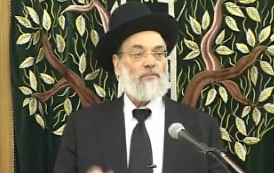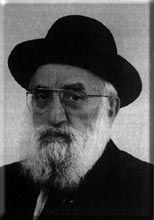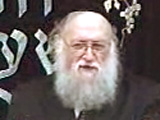Beit Midrash
- Shabbat and Holidays
- Lag Ba'omer
- Rav Shim'on Bar Yochai
The Torah study is dedicatedin the memory of
Revital Bat Lea
The higher strength of the students of Rabbi Akiva, And the hidden [strength] of the martyrs of the communities, Fuse together in the treasure of secrets of Rabbi Shimon ben Yochai. (Meged Yerachim, Iyar, 5674)
The masters of the hidden Torah need to know that the hidden Torah is strongest when it finds before it an ordered and clear physical world, healthy limbs and a strong heart, developed senses, beauty, cleanliness and purity, manners, the ways of the world, strength, a love of life and the world. Only then can the hidden Torah rule over a complete dynasty. (Orot HaKodesh, Volume I, page 97)
The greatness of the wisdom of the hidden Torah, the wisdom of truth, the original and genuine wisdom of Israel, is how through flow of the Divine spirit it elevates all of the physical to become spiritual.
This is the particular nature of the Torah of truth, all her expressions, her injunctions, even the lowest, to comprehend on the most base level the most lowly person, they speak of the Divine image, and the sanctity of the soul of that person. (ibid., page 112)
The Reasons for the Festival and the Customs of the Day
Lag Ba’Omer is the 33rd day of the counting of the Omer and that is precisely what the name Lag Ba’Omer means. Rabbi Moshe Isserlis recorded that this day is a mini-festival. It is a happy day on which the sad prayer of tachanun is not recited (see Rema on Shulchan Aruch, Orach Chayim, 493:2). The customs of mourning that we observe during the period of counting the Omer are suspended or cease altogether on Lag Ba’Omer (see Shulchan Aruch, ibid.).
A number of reasons are given as to the significance of Lag Ba’Omer as a joyous holiday. The Shulchan Aruch records that this was the day on which the students of Rabbi Akiva ceased to die. Therefore, we suspend or stop mourning for them on this day.
Another reason given for the holiday is that the famous Sage of the Mishnah, Rabbi Shimon bar Yochai, died on the 18th of Iyar, that is Lag Ba’Omer (See Aruch HaShulchan, Orach Chayim, 493:7).
On this day every year, hoards of people in Israel flock to the grave of Rabbi Shimon bar Yochai in Meiron. This site in the Galil swarms with people praying and celebrating the date of his death. It is also the custom amongst some groups of Jews to cut young boys’ hair for the first time when they are three years old. Many wait until Lag Ba’Omer for the first haircut. The grave of the great rabbi is a popular place to clip the hair and many people can be seen cutting their sons’ hair there for the first time.
There is another custom that has become very popular as well. Bonfires are made and children play with bows and arrows on Lag Ba’Omer. The reason given for this custom is that the Hebrew word for bow is keshet, and this is also the word for a rainbow. The Gemara records that during the life of Rabbi Shimon bar Yochai the rainbow was never seen (see Yerushalmi, Berachot 9:2). Rashi explains this phenomenon as being a positive sign of Rabbi Shimon’s greatness. "The rainbow is a sign that the world will not be destroyed (see BeReishit 8:8-17), but if there is a truly righteous person in the generation there is no need for the sign" (Rashi on Ketubot 77b s.v. "Im ken leit at bar lavai").
Even though this is the reason given, the bow and arrow have a distinctly military overtone to them. They seem to hint at a war, or a military message of the festival of Lag Ba’Omer. In order to explain this we need to understand who Rabbi Shimon bar Yochai was and we need to know something about his teacher, Rabbi Akiva as well.
The Greatness of Rabbi Akiva
Rabbi Shimon bar Yochai is most well known for composing the Zohar,1 the major written work of Kabbalah. He received this mystical tradition from his eminent teacher, Rabbi Akiva.
Rabbi Akiva was a true Torah giant; his halachic rulings were recorded by his students and became the normative mode of conduct for all Jews. The Gemara comments that when a Mishnah is recorded without mentioning the name of the sage that means that it was said by Rabbi Meir. When we find a similar nameless passage in the Tosefta, we know that it was said by Rabbi Nechemiah. An anonymous Sifra is attributed to Rabbi Yehudah, and an unnamed Sifrei2 to Rabbi Shimon. The Gemara concludes, "and they are all according to Rabbi Akiva" (Sanhedrin 86a). Rashi explains, "They all said these words from what they had learned from Rabbi Akiva" (Rashi ad loc.).
But Rabbi Akiva was not only the ultimate authority when it came to Halachah. Rabbi Akiva was also the master of the hidden Torah as well. He was a great kabbalist, in fact the leading kabbalist of his generation. The Gemara relates that four great rabbis entered the pardes, in the words of Rashi, "They entered on high through using the Holy Name." The word pardes is an acronym for p’shat, remez, drash, and sod, the four levels of understanding the Torah. These are: the simple understanding called p’shat, allusions in the text called remez, elucidation called drash, and finally sod, meaning secrets, the concepts hidden in the text of Torah, that is, the kabbalistic explanations of the Torah, also called the hidden Torah.
"Four entered the pardes and they were: Ben Azai, Ben Zoma, Acher,3 and Rabbi Akiva." Rabbi Akiva then gave the other rabbis some tips on how to navigate around the spiritual world that they were entering into. "Ben Azai peeked [at the Divine] and died, Ben Zoma peeked and was harmed (Rashi - "he went mad"), Acher picked seedlings [and came out a heretic], Rabbi Akiva came out peacefully" (Chagigah 14b). Even though all the other rabbis were adversely affected, Rabbi Akiva entered and exited the spiritual world peacefully. This was due to his superior kabbalistic ability.
Rabbi Akiva’s War
So we have seen that Rabbi Akiva was a Torah scholar whose expertise encompassed both Halachah and the inner secrets of the Torah. There is one more aspect of Rabbi Akiva’s personality that is mentioned by the Rambam.
The Rambam discusses the requirements and qualifications for the messianic king, Melech haMashiach. "Do not assume that the Melech haMashiach needs to perform miracles and wonders and change the world, or revive the dead, or any such thing. This is not the case" (Mishneh Torah, Hilchot Melachim 11:3). The messianic era and the messianic leader do not have to be miraculous in order to be genuine. The Rambam proves this with the example set by Rabbi Akiva himself.
"Rabbi Akiva was a great sage, one of the Sages of the period of the Mishnah, and he carried arms for Bar Kosiva the king. He claimed that he was the Melech haMashiach. He [Rabbi Akiva] and all the Sages of his generation said that he [Bar Kosiva] was the messianic king, until he was killed through his sins and then they realized that he was not [the messianic leader] and the Sages never requested that he perform a sign or a wonder."
The Rambam presents an example of a great sage and many others of his generation who held up someone to be the Mashiach, at least in potential. The example that he brings is that of Rabbi Akiva4 who supported Bar Kosiva, another name for Bar Kochba. Bar Kochba waged war on the Roman invaders of Israel and beat them back for two and a half years. Eventually he was killed and it was revealed to the Sages that he was not the messiah.5
The support that Rabbi Akiva afforded Bar Kochba is understood; he saw his struggle against the Roman oppressors as correct. The war was waged to restore Jewish pride and nationalistic feelings. These are definitely elements of a messianic rule and messianic ruler. We see that Rabbi Akiva’s student, Rabbi Shimon bar Yochai, also voiced strong anti-Roman feelings.
Rabbi Yehudah, Rabbi Yosi, and Rabbi Shimon bar Yochai were sitting together and Rabbi Yehudah ben Gerim joined them. Rabbi Yehudah said, "How good are the actions of this nation [Rashi - the Romans], they established markets, bridges, bathhouses." Rabbi Yosi did not comment, Rabbi Shimon bar Yochai answered and said, "All that they established they did for themselves. They set up markets in order to house prostitutes, bathhouses to pamper themselves, and bridges to take tolls."
Rabbi Yehudah ben Gerim went and told [Rashi - he told his students or his parents, not that he told on them to the authorities, but it became known to the authorities] and the authorities heard.
They said, "Yehudah who praised shall be promoted, Yosi who made no comment will be exiled to Tzipori, Shimon who criticized will be put to death" (Shabbat 33b).
The end of the story was that Rabbi Shimon bar Yochai had to escape. He hid in a cave together with his son for twelve years. They both learned Torah and were nourished by a carob tree that grew near the mouth of the cave.
So we see that there was resistance to the Roman conquest and influence. However, the Rambam used an unusual phrase to describe Rabbi Akiva’s relationship with Bar Kochba. It was more than just moral support. Rabbi Akiva actually carried arms for Bar Kochba and actively took part in the fight against the Romans.
We could ask whether this was appropriate behavior for Rabbi Akiva. After all, we have already seen that he was a Torah giant in both halachah and Kabbalah. It was fair for him to express support for Bar Kochba and his struggle, but was it right for him to join the battle himself?
In order to answer this question we need to understand something about Kabbalah and the mystical experience in Judaism.
Practical Kabbalah
Kabbalah is a discussion and a description of the Divine, spiritual universe. There is a spiritual reflection of this world, a Divine realm of existence. Part of Kabbalah is a method of entering that world. Thus we can understand Rashi’s comment when the Gemara said that the four rabbis entered the pardes, that "they entered on high through using the Holy Name." They knew the kabbalistic method of entering "on high," that is, the Divine realm.
Another part of Kabbalah is a description of the spiritual world; it is like a map of the Divine world. The final part of Kabbalah is a discussion of what one can do when one enters that realm. If the physical world is mirrored in this spiritual world, then if we can effect changes there, they will influence and alter states in this world as well. That is the practical Kabbalah.
Today most kabbalists study the first two parts of Kabbalah, but the final part of the Kabbalah, that of practical Kabbalah has almost been lost. We do not know how to use our spiritual knowledge to influence and affect the world. However, this is a major part of Kabbalah. This suggests to us an important principle with regard to the Kabbalah. Kabbalah is very different from other mystical traditions. In mysticism the practitioner enters a spiritual realm and this takes him or her away from the physical world. The mystic is aloof and removed from the outside world. Mysticism becomes a form of escape and detachment from the physical world.
Kabbalah is very different. Not only does the Kabbalah not desire to remove the kabbalist from the physical world, but the ultimate level of Kabbalah is, in fact, the ability to change and improve the physical world. The kabbalist is not removed from the world; the opposite is the case. Kabbalists are married and have families, they live among the people and help those around them.
In this light we can understand the behavior of Rabbi Akiva with regard to Bar Kochba.
The Glory of Israel
Rabbi Akiva’s learning and kabbalistic mastery did not mean that he closeted himself in an ivory tower of Torah scholarship. He was intensely involved in the world around him. The stories of Rabbi Akiva and his love affair with Rachel his wife are legendary and recorded in the rabbinic texts. Rabbi Akiva also took an active part in the wars of Bar Kochba. He did not hide behind his status as a Torah giant but he was in the front line of battle. He carried arms for Bar Kochba and encouraged his students to do the same. Rabbi Akiva did not see a contradiction between fighting Israel’s wars and learning Torah. On the contrary, he recognized that these were two sides of the same coin. Both studying Torah and fighting for Jewish independence and survival were acts of serving God.
The Gemara taught that the desecration of God’s Name, called chilul Hashem, is one of the most severe sins. One cannot repent for this sin as it affects not only the individual but God and His entire world as well (See Yoma 86a). The prophet Yechezkel said that an example of the desecration of God’s Name is when the Jewish people are in exile. "They will come to the nations and they will desecrate My holy Name, when they will say that these are the people of God and they have left their land" (Yechezkel 36:20).
The fact that the Jews were expelled from their land and dwell outside their natural habitat has a great influence on the Jewish people. But they are not the only ones who are affected. The entire world looks at the fate of the Jews and draws conclusions with regard to the place of the Jews in the world and their relationship with the Almighty.
If the Jews can be ejected from Israel there are two possible logical conclusions: either God is not as powerful as was previously thought, and therefore other nations managed to overcome His people, or the Jews are no longer the chosen nation, and they have been rejected by God. Both of these are a desecration of the Divine Name. (See Rashi ad loc. and Rashi on Yoma 86a s.v. "B’emor lahem Am Hashem eileh umiartzo yatzau.")
Rabbi Akiva understood this and so he took up arms and fought in order to prevent such a calamity from happening. His attempt was valiant but it did not succeed. Eventually the Romans conquered the Jewish nation and the Jews were led into exile.
Strength in Exile
However, even in exile the Jews had the opportunity to sanctify God’s Name, not as a nation but as individuals. The gentiles attacked the Jews and attempted to convert them to other religions. Some Jews succumbed to the pressure, but many succeeded in resisting. Some escaped, others were killed, by the thousands and tens of thousands. Still they stuck fast to their Judaism and their faith in God.
The period between Pesach and Shavuot was a time when many martyrs were killed. Their strength was immense but it was not given military expression. Their strength was silent and hidden. It was proven by their ability to accept the evil decree, not by their ability to fight.
In the words of Rav Kook, "The higher strength of the students of Rabbi Akiva, and the hidden [strength] of the martyrs of the communities fuse together in the treasure of secrets of Rabbi Shimon bar Yochai."
Rabbi Akiva’s strength was drawn from the same source as the hidden strength of the martyrs. They both emanated from a belief in God and a faith that He would protect and comfort His nation. That is expressed most eloquently and clearly in the kabbalistic writings of Rabbi Akiva’s student, Rabbi Shimon bar Yochai.
That is the message of Lag Ba’Omer. We must draw inner strength from the pearls of the hidden wisdom of the Torah. As a nation we have to learn how to translate the greatness of the secrets of Torah into a practical system that will show us how to act and enable us to survive and flourish.
--------------------
To see and buy the book please go to: http://www.growingjewish.com

Success and Ideal
Rabbi Ya'akov Peleg | Iyar 5767

Rashbi - Basing Law on Thought
Rabbi David Dov Levanon | Iyar 5768

The Secrets of Lag BaOmer
Rabbi Yossef Carmel | Iyar 12 5782























